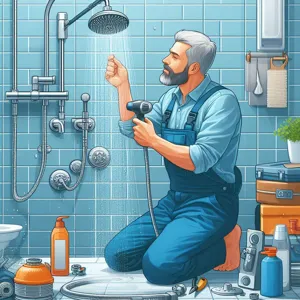Upgrading your shower head can transform your daily routine into a luxurious spa-like experience, but the thought of installation might seem daunting.
Fear not! With the right tools and a bit of guidance, you can easily install your new shower head like a pro, saving both time and money while elevating your bathroom’s style and functionality. In this step-by-step guide, we’ll walk you through the entire process—from gathering necessary tools and selecting the perfect shower head to removing the old fixture and installing the new one with confidence. Whether you’re a seasoned DIY enthusiast or a first-time homeowner, our clear instructions and helpful tips will ensure your shower upgrade is smooth and hassle-free. Get ready to enjoy a refreshing shower experience that feels just right!
1. Introduction: Why Upgrade Your Shower Head?

Upgrading your shower head might seem like a small change, but it can have a significant impact on your daily routine and overall bathroom experience. Imagine stepping into the shower each morning and being greeted by a revitalizing cascade of water that washes away fatigue and stress. Investing in a new shower head can transform an ordinary shower into a luxurious spa-like retreat, elevating your home’s comfort and functionality.
Not only does a new shower head enhance your bathing experience, but it can also contribute to water efficiency, helping you save on utility bills while being environmentally conscious. Modern shower heads come equipped with innovative features, such as adjustable spray settings, built-in water-saving technology, and even Bluetooth connectivity for a truly immersive experience.
Furthermore, a stylish shower head can serve as a statement piece, adding a touch of elegance to your bathroom decor. With a variety of designs and finishes available—from sleek chrome to rustic bronze—you can easily find a model that complements your personal style and elevates the aesthetic of your space.
In this step-by-step guide, we’ll walk you through the process of installing your new shower head like a pro, ensuring you not only enjoy the benefits of this upgrade but also gain the satisfaction of completing the project yourself. Whether you’re a seasoned DIY enthusiast or a first-time homeowner, you’ll find that with the right tools and guidance, transforming your shower has never been easier. So, let’s dive in and discover how a simple upgrade can lead to a more enjoyable and efficient showering experience!
2. Tools and Materials You’ll Need
Before diving into the installation process, it’s essential to gather all the necessary tools and materials. Having everything on hand not only streamlines the installation but also ensures that you won’t have to make any last-minute trips to the hardware store. Here’s a comprehensive list to help you get started:
**1. Adjustable Wrench:** This versatile tool will help you easily tighten or loosen the nuts and bolts that secure your shower head in place. A wrench with a rubber grip can also provide better leverage and prevent damage to the fittings.
**2. Plumber’s Tape (Teflon Tape):** This handy tape is crucial for creating a watertight seal around the threads of your shower arm. It prevents leaks and ensures that your new shower head functions smoothly.
**3. Screwdriver:** Depending on your shower head model, you may need a Phillips or flathead screwdriver. This will help you remove the old shower head and secure the new one properly.
**4. Bucket or Towel:** To catch any remaining water that may drip from the shower arm during the installation process, have a bucket or towel ready. This will help keep your bathroom dry and free from puddles.
**5. Cleaning Cloth:** A clean cloth or rag will come in handy for wiping down the shower arm and ensuring a clean surface for the new shower head. This step is essential for maintaining a good seal and preventing any debris from interfering with the installation.
**6. New Shower Head:** Of course, you’ll need the star of the show—the new shower head! Whether you’ve chosen a sleek rain shower head or a versatile handheld option, make sure it’s compatible with your existing setup.
By having these tools and materials ready before you begin, you’ll set yourself up for a smooth and successful installation process. Now that you’re equipped with everything you need, you’re one step closer to enjoying your luxurious new shower experience!
3. Choosing the Right Shower Head for Your Needs

Choosing the right shower head for your needs is a crucial step in ensuring an enjoyable and satisfying shower experience. With a plethora of options available, it can be overwhelming to decide which one best suits your preferences and lifestyle. Start by considering the type of shower head that will work best for your space. Are you looking for a fixed shower head, which is mounted to the wall and offers a sleek, minimalist design? Or perhaps a handheld shower head, which provides flexibility and ease of use, making it perfect for rinsing off after a workout or for bathing children and pets.
Next, think about the water pressure in your home. If you have high water pressure, a rain shower head might be an ideal choice, providing a luxurious downpour that mimics a gentle rainfall. However, if your water pressure is on the lower side, you may want to opt for a shower head designed to conserve water while still delivering a powerful spray. Look for models that feature air-infusion technology, which can enhance the flow while using less water.
Don’t forget to consider the spray patterns! Many modern shower heads come with adjustable settings, allowing you to switch between a soft mist, invigorating massage, or a refreshing power spray. This versatility can enhance your shower experience, making it more enjoyable and tailored to your mood.
Lastly, check for additional features that might appeal to you. Some shower heads come with built-in water filters to remove harmful contaminants, while others boast easy-clean nozzles to prevent limescale buildup. By taking the time to evaluate your needs and preferences, you can select a shower head that not only meets your practical requirements but also transforms your daily routine into a rejuvenating escape. With the right choice in hand, you’ll be well on your way to enjoying a shower experience that feels like a spa retreat in your own home!
4. Preparing Your Workspace: Safety First!
Before diving into the installation process, it’s essential to prioritize safety and prepare your workspace effectively. A well-organized area not only enhances efficiency but also minimizes the risk of accidents. Start by gathering all the necessary tools and supplies. You’ll need an adjustable wrench, plumber’s tape, and a bucket or towel to catch any stray water.
Next, clear the area around your shower to create ample space for movement. Remove any items from the shower shelf or surrounding surfaces, such as toiletries, loofahs, or bath mats. This step not only prevents clutter but also protects your belongings from water splashes or accidental damage during installation.
Now, let’s talk about safety measures. Before you begin, ensure that the water supply to your shower is turned off. This will prevent any unwanted water flow during the installation, which can lead to slippery surfaces and potential falls. Additionally, it’s a good idea to lay down a non-slip mat to provide extra traction while you’re working in the shower.
If your new shower head requires any specific tools or adjustments, read through the manufacturer’s instructions beforehand. Understanding the requirements will help you anticipate any challenges that may arise during installation.
Lastly, consider wearing safety goggles to protect your eyes from any debris or water that may splash up as you work. By taking these preparatory steps and putting safety first, you’ll set yourself up for a smooth and successful shower head installation, ensuring that you can enjoy your new fixture without worry!
5. Step 1: Turn Off the Water Supply

Before diving into the installation process, the very first step—arguably one of the most crucial—is to turn off the water supply. This precaution not only ensures your safety but also prevents a cascade of water from flooding your bathroom during the installation.
To begin, locate the main water shutoff valve for your home, which is typically found in the basement, crawl space, or near the water meter. In some cases, you may find a dedicated shutoff valve for your bathroom located beneath the sink or close to the shower itself. Once you’ve identified the correct valve, twist it clockwise until it stops. This action halts the flow of water, giving you peace of mind as you proceed.
After you’ve turned off the water supply, it’s a good idea to release any remaining pressure in the pipes. Simply turn on the shower faucet and allow it to run until the water stops flowing. This step will help minimize any surprise splashes when you remove the old shower head.
With the water supply now securely off and pressure relieved, you’re ready to tackle the next steps in the installation process. This careful preparation sets the stage for a smooth and professional-looking shower head upgrade. Remember, taking your time with these initial steps will pay off in the long run, ensuring a hassle-free installation experience.
6. Step 2: Remove the Old Shower Head
Once you’ve gathered your tools and prepared the area, it’s time to tackle the second step: removing the old shower head. This process is straightforward, but it’s essential to approach it with care to avoid any mishaps.
Begin by ensuring that the water supply to the shower is turned off. This is typically done at the main water valve, but if you have individual shut-off valves for the shower, those will work just as well. After confirming that the water is off, it’s a good idea to place a towel or bucket beneath the shower head to catch any residual water that might spill out during the removal process.
Next, locate the connection point where the shower head is attached to the arm. Most shower heads are screwed on, so you’ll want to use an adjustable wrench or pliers to grip the base of the shower head securely. If it’s stuck, applying a gentle rocking motion can help loosen it. Be cautious not to apply too much pressure, as this could damage the shower arm or the plumbing.
If the old shower head has been in place for a while, you may encounter mineral buildup or corrosion that makes it challenging to remove. In such cases, a penetrating oil can be sprayed around the connection point. Let it sit for a few minutes to work its magic before attempting to unscrew the shower head again.
As you unscrew the old fixture, it’s advisable to turn it counterclockwise while supporting the shower arm with your other hand to prevent any twisting or bending. Once it’s detached, inspect the threads on the shower arm for any debris or damage. Cleaning the threads with a cloth will ensure a proper seal when you install your new shower head.
With the old shower head removed and the area clean, you’re now ready to proceed to the next step in your installation journey. This stage lays the groundwork for a smooth and successful upgrade, setting you up for a refreshing shower experience with your new fixture!
7. Step 3: Clean the Shower Arm Threads

Before you can attach your shiny new shower head, it’s essential to ensure that the shower arm threads are clean and free from any debris or old plumber’s tape. This step is crucial for achieving a watertight seal and preventing leaks down the line.
Start by inspecting the threads of the shower arm, which is the pipe protruding from the wall. Over time, mineral deposits, soap scum, and remnants of old tape can accumulate, creating a rough surface that can hinder a secure fit. To clean it effectively, grab a clean cloth or an old toothbrush and gently scrub the threads, removing any buildup.
If you notice stubborn residue, a mixture of vinegar and water can work wonders. Soak a cloth in the solution and wrap it around the threaded area for a few minutes to dissolve any grime. Once the threads are clean, dry them thoroughly with a clean towel.
For an added layer of protection against leaks, consider applying a fresh layer of plumber’s tape (also known as Teflon tape) around the threads. This tape not only helps create a tight seal but also makes it easier to unscrew the shower head in the future if needed. Simply wrap the tape around the threads in a clockwise direction, ensuring it’s snug but not overly thick. With clean threads prepped and ready, you’re one step closer to transforming your shower experience!
8. Step 4: Apply Teflon Tape for a Tight Seal
Now that you’ve removed the old shower head and cleaned the threaded pipe, it’s time to ensure a leak-free connection with a simple yet crucial step: applying Teflon tape. This special tape, often referred to as plumber’s tape, is designed to create a watertight seal that prevents leaks and drips, making it a must-have for any plumbing project.
Start by taking a length of Teflon tape—about three to four inches should suffice. Hold the tape in one hand and begin wrapping it around the threaded end of the shower arm (the pipe that sticks out from the wall) in a clockwise direction. It’s important to wrap it in the same direction that you will be screwing on the new shower head; this way, the tape won’t unravel as you tighten the fitting.
Be mindful not to overdo it; around two to three complete wraps are usually adequate. Too much tape can actually hinder the connection and make it difficult to screw the shower head on securely. As you wrap, ensure the tape adheres smoothly and evenly without any overlaps or bulges. This attention to detail will help to create a solid barrier against leaks.
Once you’ve finished applying the tape, give it a gentle press to secure it in place. You’re now ready to move on to the next step—attaching your new shower head. With the Teflon tape in place, you can proceed with confidence, knowing you’ve taken the right measures to achieve a tight seal and prevent any unwanted waterwork mishaps!
9. Step 5: Install the New Shower Head
Once you’ve successfully removed the old shower head, it’s time for the exciting part: installing your new shower head! This step is where your efforts truly begin to pay off, transforming your bathroom’s look and feel.
Before diving in, make sure you have your new shower head and the necessary tools ready—typically, you’ll need an adjustable wrench, plumber’s tape, and a microfiber cloth. Start by taking a moment to inspect the threads on the shower arm; they should be clean and free of debris. If you notice any old tape or residue, gently clean it off with your cloth to ensure a tight seal.
Next, take your plumber’s tape and wrap it around the threads of the shower arm. This step is crucial as it creates a watertight seal, preventing any leaks once you turn the water back on. Be sure to wrap the tape in the direction of the threads, usually clockwise, and apply about two to three layers for added security.
Now, it’s time to attach the new shower head. Carefully screw it onto the shower arm by hand, turning it clockwise until it feels snug. Avoid using excessive force at this stage; overtightening can damage the shower head or the arm. Once it’s hand-tight, use your adjustable wrench to make a slight turn—just enough to secure it, but be cautious not to overdo it.
Finally, step back and admire your handiwork! Before you declare victory, it’s wise to test for leaks. Turn on the water and check around the connection for any drips. If you notice any, gently tighten the shower head a little more until the leak stops.
With your new shower head securely in place, you’re ready to enjoy a refreshing shower experience that will make you feel like you’re stepping into a spa every day!
10. Step 6: Adjust the Angle and Position
Once your new shower head is securely installed, it’s time to fine-tune its angle and position for the ultimate shower experience. This step is crucial because a well-angled shower head can make all the difference in how water flows and how comfortably you can bathe.
Begin by standing in your shower and mimicking your usual bathing stance. This will help you determine the optimal height and direction for your shower head. Using your hands, gently swivel the shower arm or adjustable mount to align the head with your desired angle. If your shower head is fixed, you might need to loosen the mounting nut slightly to adjust its position before retightening it.
Consider factors like your height and personal preferences—some people prefer a more direct spray, while others enjoy a wider, more diffused flow. If your shower head features different spray settings, take a moment to experiment with each one to find the perfect angle for each mode.
Once you’ve configured the angle, turn on the water to test the flow. Observe how the water hits you and adjust accordingly until you achieve the ideal position. A slight tweak can make a significant difference, ensuring that you enjoy a refreshing experience every time you step into your shower. This careful attention to detail not only enhances your comfort but also optimizes the efficiency of your new shower head. With this final adjustment complete, you’re all set to enjoy a spa-like experience right in the comfort of your own home!
11. Step 7: Turn the Water Supply Back On
After you’ve successfully installed your new shower head, it’s time to turn your attention to the final step: turning the water supply back on. This is a moment of anticipation, as you’re about to reveal the fruits of your labor. Start by locating the water supply valve, which is typically found under the sink or near the shower itself.
Before flipping the valve open, take a moment to double-check your work. Ensure that all connections are tight and secure, and that no tools or materials are left in the shower area. This little precaution can save you from any potential mishaps when the water starts flowing.
Once you’re satisfied everything is in order, slowly turn the valve back to the open position. You may hear the rush of water as it courses back through the pipes, and this is where the excitement builds. It’s advisable to let the water run for a minute or two to flush out any debris that may have accumulated during your installation process.
As the water begins to flow, observe closely for any leaks around the fittings. If you notice any drips, it may indicate that adjustments are necessary—tightening the connection or reapplying plumber’s tape can often resolve minor issues. Once you’re confident that everything is sealed properly, it’s time to test your new shower head.
Turn on the shower and revel in the refreshing spray of water, adjusting the settings to your liking. Not only will you feel a sense of accomplishment for completing the installation yourself, but you’ll also enjoy the satisfaction of a new shower experience that enhances your daily routine. Congratulations! You’ve successfully installed your new shower head like a pro!
12. Step 8: Test for Leaks and Adjust as Necessary
After you’ve successfully attached your new shower head, the moment of truth arrives—it’s time to test for leaks and make any necessary adjustments. This step is crucial not just for ensuring a watertight fit, but also for preventing future water damage and maintaining the efficiency of your plumbing system.
Begin by turning on the water at a moderate pressure. As the water flows through the shower head, closely examine the connection between the shower arm and the head itself. Look for any signs of dripping or pooling water—this is an indication that you may need to tighten the connection or add more plumber’s tape to create a better seal.
If you notice any leaks, don’t panic! Simply turn off the water and use a wrench to gently tighten the shower head. Be cautious not to overtighten, as this can lead to damage or cracks. If leaks persist, it might be a sign that the rubber washer inside the shower head needs replacement or that the threads aren’t aligned correctly.
Once you’ve made your adjustments, turn the water back on and conduct a thorough check again. Listen for any unusual sounds, such as hissing or dripping, and watch for any water escape. If everything looks good, you can relax knowing your installation was successful. A well-fitted shower head not only enhances your bathing experience but also ensures that your bathroom remains dry and damage-free.
Completing this step with diligence will leave you with a shower head that operates flawlessly and provides years of refreshing showers—just like a pro!
13. Tips for Maintaining Your New Shower Head
Once you’ve successfully installed your new shower head, the key to ensuring it continues to perform beautifully lies in proper maintenance. With a few simple tips, you can keep your shower head in top condition for years to come, enhancing both its functionality and your shower experience.
First and foremost, regular cleaning is essential. Over time, mineral deposits from hard water can accumulate and clog the nozzles of your shower head, leading to reduced water flow and a less satisfying shower. To prevent this, consider a routine cleaning schedule—every few weeks is a good starting point. You can easily tackle buildup by filling a plastic bag with equal parts vinegar and water, then securing it around the shower head with a rubber band. Let it soak for a few hours, then remove the bag and run the shower for a minute to flush out any loosened debris.
Additionally, always check the water pressure. If you notice a sudden change in your shower’s performance, it could be worth investigating your home’s plumbing. High water pressure can lead to leaks or even damage your shower head, while low pressure can result in a disappointing shower experience. If necessary, consult a plumber to adjust the pressure to a safe and effective level.
Another important aspect of maintenance is inspecting the shower head for leaks. Regularly check the connections for any signs of dripping or moisture. If you notice a leak, tightening the fittings can often solve the problem. However, if that doesn’t work, you may need to replace the washer or consult a professional.
Lastly, consider the longevity of your shower head. While many modern shower heads are designed to be durable, keeping the manufacturer’s recommendations in mind for usage and cleaning will help preserve its lifespan. If your shower head has a filter, be sure to clean or replace it as directed, ensuring that your water remains clean and enjoyable.
By following these maintenance tips, you’ll not only extend the life of your new shower head but also enjoy a consistently invigorating shower experience that keeps you refreshed day after day. With just a little attention and care, your shower head can continue to be a source of relaxation and rejuvenation for years to come.
14. Common Installation Mistakes to Avoid
When it comes to installing your new shower head, even the most well-intentioned DIY enthusiasts can make a few blunders along the way. To ensure your shower upgrade goes off without a hitch, it’s crucial to be aware of common installation mistakes that can lead to frustration and even costly repairs. Here are some pitfalls to avoid:
**1. Skipping the Prep Work:** One of the biggest mistakes is diving straight into installation without prepping the area. Take the time to remove the old shower head carefully, ensuring you have the right tools on hand. Cleaning the threads of the shower arm is essential for a proper seal. Failing to do so can lead to leaks down the line.
**2. Over-tightening Connections:** It might seem logical to tighten your new shower head as much as possible to prevent leaks, but over-tightening can lead to damage. Use a wrench if necessary, but apply just enough pressure to create a snug fit. A little plumber’s tape on the threads can help ensure a leak-free seal without the need for excessive force.
**3. Neglecting to Check for Compatibility:** Not all shower heads are created equal. Before purchasing your new fixture, ensure it’s compatible with your existing plumbing. Read the product specifications carefully and confirm the thread sizes match. Installing an incompatible shower head can lead to leaks or a poor fit.
**4. Ignoring Flow rate and Pressure:** While you may be excited about your new shower head, don’t forget to consider the water flow rate and pressure. Some shower heads offer a luxurious rain-like experience, but if the flow rate exceeds your plumbing system’s capacity, you may end up with frustratingly low water pressure. Research the specifications to avoid disappointment.
**5. Forgetting to Test for Leaks:** After installation, it can be tempting to jump right into a refreshing shower, but it’s crucial to take a moment to test for leaks. Turn on the water and check all the connections carefully. If you notice any drips, turn off the water, tighten the connections, or readjust the plumber’s tape as needed.
By being aware of these common mistakes, you can navigate your shower head installation with confidence and ease. With just a little attention to detail, you’ll be able to enjoy your new shower fixture without the headaches that come from avoidable errors. Happy installing!
15. Conclusion: Enjoy Your Upgraded Shower Experience!
Congratulations! You’ve successfully installed your new shower head, and now it’s time to revel in the fruits of your labor. Imagine stepping into your bathroom and being greeted by a refreshing cascade of water that transforms your daily routine into a luxurious spa-like experience. Whether your new shower head features adjustable settings, a rainfall effect, or water-saving technology, each option enhances your shower in ways that can elevate your mood and rejuvenate your body.
As you turn on the water and feel the flow, take a moment to appreciate the satisfaction of having done it yourself. No more waiting for a plumber or dealing with the frustration of an outdated fixture. You’ve taken control of your home improvement project, and what better reward than the invigorating sensation of a perfectly functioning shower?
Remember to periodically check your installation to ensure everything is functioning smoothly. Regular maintenance, such as cleaning the shower head to prevent mineral buildup, will help maintain the performance and longevity of your new purchase.
In conclusion, enjoy the upgraded shower experience you’ve created! It’s not just about the aesthetics or the functionality; it’s about the daily moments of joy that come from your new routine. So go ahead, indulge in that long, relaxing shower you’ve been dreaming of—you’ve earned it!
Congratulations! You’re now equipped with all the knowledge you need to install your new shower head like a pro. By following our step-by-step guide, you can transform your bathroom experience with ease and confidence. Whether you opted for a sleek modern design or a classic style, the satisfaction of completing this DIY project yourself is unmatched. Not only will you enjoy the upgraded functionality and aesthetics of your new shower head, but you’ll also save time and money by bypassing the need for a plumber. So go ahead—turn on the water, bask in your handiwork, and revel in the soothing shower experience you’ve created. We’d love to hear about your installation journey, so feel free to share your tips or photos in the comments below!






